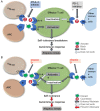Vitamin D and alopecia areata: possible roles in pathogenesis and potential implications for therapy
- PMID: 31632510
- PMCID: PMC6789271
Vitamin D and alopecia areata: possible roles in pathogenesis and potential implications for therapy
Abstract
Alopecia areata is characterized by the loss of hair on the scalp and elsewhere on the body. It affects approximately 2% of the general population. It is believed to be an autoimmune disease. However, its pathogenesis remains incompletely understood. Recent studies have revealed a substantial link between vitamin D and alopecia areata. But the underlying mechanism still yet to be deciphered. This article reviews the current literature and discusses the possible roles of vitamin D in the pathogenesis of alopecia areata in the context of (1) loss of immune privilege in hair follicle, (2) autoreactive effector T cells and mast cells, (3) nature killer group 2 member d-positive cytotoxic T cells, (4) Janus kinase/signal transducers and activators of transcriptional signaling pathway, (5) regulatory T cells, (6) immune checkpoints, and (7) oxidative stress, which are believed to play important roles in autoimmunity in AA. This paper provides new insights into research directions to elucidate the exact mechanisms of vitamin D in the pathogenesis. Calcipotriol, a vitamin D analog, has been reported to be topically used in treating alopecia areata with promising results. Combination therapy of vitamin D analogs with corticosteroids might also be used in treating alopecia areata.
Keywords: Alopecia areata; autoimmune; calcipotriol; vitamin D.
AJTR Copyright © 2019.
Conflict of interest statement
None.
Figures



Similar articles
-
Vitamin D and Alopecia Areata: From Mechanism to Therapeutic Implications.Skin Appendage Disord. 2025 Apr 15:1-11. doi: 10.1159/000545711. Online ahead of print. Skin Appendage Disord. 2025. PMID: 40433551 Free PMC article.
-
Alopecia areata: Animal models illuminate autoimmune pathogenesis and novel immunotherapeutic strategies.Autoimmun Rev. 2016 Jul;15(7):726-35. doi: 10.1016/j.autrev.2016.03.008. Epub 2016 Mar 10. Autoimmun Rev. 2016. PMID: 26971464 Free PMC article. Review.
-
Recent advances in the pathogenesis of autoimmune hair loss disease alopecia areata.Clin Dev Immunol. 2013;2013:348546. doi: 10.1155/2013/348546. Epub 2013 Sep 18. Clin Dev Immunol. 2013. PMID: 24151515 Free PMC article. Review.
-
The autoimmune basis of alopecia areata: a comprehensive review.Autoimmun Rev. 2015 Feb;14(2):81-9. doi: 10.1016/j.autrev.2014.10.014. Epub 2014 Oct 12. Autoimmun Rev. 2015. PMID: 25315746 Review.
-
The current state of knowledge of the immune ecosystem in alopecia areata.Autoimmun Rev. 2022 May;21(5):103061. doi: 10.1016/j.autrev.2022.103061. Epub 2022 Feb 10. Autoimmun Rev. 2022. PMID: 35151885 Free PMC article. Review.
Cited by
-
Association Between Vitamin D and Zinc Levels With Alopecia Areata Phenotypes at a Tertiary Care Center.Cureus. 2021 Apr 28;13(4):e14738. doi: 10.7759/cureus.14738. Cureus. 2021. PMID: 34079683 Free PMC article.
-
New and Emerging Therapies for Alopecia Areata.Drugs. 2020 May;80(7):635-646. doi: 10.1007/s40265-020-01293-0. Drugs. 2020. PMID: 32323220 Review.
-
Associations between ionomic profile and metabolic abnormalities in a murine model of sodium sulfide induced alopecia areata.Front Pharmacol. 2025 May 14;16:1507348. doi: 10.3389/fphar.2025.1507348. eCollection 2025. Front Pharmacol. 2025. PMID: 40438604 Free PMC article.
-
Combination of topical anthralin and calcipotriene in alopecia areata: A discussion of the mechanisms of action.JAAD Case Rep. 2020 May 22;6(7):673-674. doi: 10.1016/j.jdcr.2020.05.022. eCollection 2020 Jul. JAAD Case Rep. 2020. PMID: 32743037 Free PMC article. No abstract available.
-
Alopecia Areata: A Review of the Role of Oxidative Stress, Possible Biomarkers, and Potential Novel Therapeutic Approaches.Antioxidants (Basel). 2023 Jan 6;12(1):135. doi: 10.3390/antiox12010135. Antioxidants (Basel). 2023. PMID: 36670997 Free PMC article. Review.
References
-
- Strazzulla LC, Wang EHC, Avila L, Lo Sicco K, Brinster N, Christiano AM, Shapiro J. Alopecia areata: disease characteristics, clinical evaluation, and new perspectives on pathogenesis. J Am Acad Dermatol. 2018;78:1–12. - PubMed
-
- Tsai TY, Huang YC. Vitamin D deficiency in patients with alopecia areata: a systematic review and meta-analysis. J Am Acad Dermatol. 2018;78:207–209. - PubMed
-
- Çerman AA, Solak SS, Altunay İ, Küçükünal NA. Topical calcipotriol therapy for mild-to-moderate alopecia areata: a retrospective study. J Drugs Dermatol. 2015;14:616–620. - PubMed
Publication types
LinkOut - more resources
Full Text Sources
